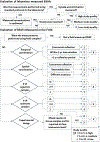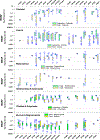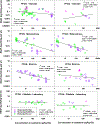Biota-Sediment Accumulation Factors for Per- and Polyfluoroalkyl Substances
- PMID: 36398857
- PMCID: PMC11519828
- DOI: 10.1002/etc.5526
Biota-Sediment Accumulation Factors for Per- and Polyfluoroalkyl Substances
Abstract
Per- and polyfluoroalkyl substances (PFAS) are widely used in commercial products such textiles, firefighting foams, and surface coatings across the globe and some PFAS are known to be bioaccumulative in aquatic species. The ultimate sink for numerous anthropogenic chemicals is the sediments in lakes, rivers, and oceans. To understand the relationship between sediment and aquatic species, a literature search was performed and biota-sediment accumulation factors (BSAFs) data for 17 taxonomic classes were assembled. The carbonyl and sulfonyl PFAS classes were relatively data rich whereas phosphate (no measurements), ether (one chemical), and fluorotelomer (limited number of chemicals) PFAS classes were data poor. Taxonomic classes of Teleostei and Clitellata had the largest BSAFs whereas Magnoliopsida and Bivalvia had the smallest BSAFs, and BSAF values >1 (kg-OC/kg-wet wt) were very rare. Across all studies, median (±standard deviation) whole-body Teleostei BSAFs for perfluorooctane sulfonic acid and perfluorooctanoic acid (kg-OC/kg-wet wt) were 0.0580 (±0.445, n = 60) and 0.00283 (±0.103,24), respectively. Laboratory-measured BSAFs were consistently larger than field-measured BSAFs, that is, 53 of 67 comparisons were larger (80%). Comparing BSAFs across taxonomic classes, 72% of the BSAFs were significantly different (α = 0.05). Comparing BSAFs within a taxonomic class, BSAFs were significantly different for 63% of the taxonomic classes. Elimination kinetics for benthic invertebrates suggests steady-state conditions might be reached in the 28-day uptake portion of a laboratory bioaccumulation test for some test species. The largest data gaps, beyond limited measurements, are understanding the effects of concentration and mixtures on bioaccumulation from sediments, quantifying the difference, if any, in BSAFs between freshwater and brackish/marine ecosystems, and models for predicting BSAFs based on concentrations in sediment. Environ Toxicol Chem 2023;42:277-295. © 2022 SETAC. This article has been contributed to by U.S. Government employees and their work is in the public domain in the USA.
Keywords: BSAF; Bioaccumulation; Biota-sediment accumulation factor; PFASs; fish; per- and polyfluoroalkyl substances; sediment.
© 2022 SETAC. This article has been contributed to by U.S. Government employees and their work is in the public domain in the USA.
Conflict of interest statement
Figures






Similar articles
-
Evaluation of Published Bioconcentration Factor (BCF) and Bioaccumulation Factor (BAF) Data for Per- and Polyfluoroalkyl Substances Across Aquatic Species.Environ Toxicol Chem. 2021 Jun;40(6):1530-1543. doi: 10.1002/etc.5010. Epub 2021 May 13. Environ Toxicol Chem. 2021. PMID: 33605484 Review.
-
Bioaccumulation of per- and polyfluoroalkyl substances by freshwater benthic macroinvertebrates: Impact of species and sediment organic carbon content.Sci Total Environ. 2023 Mar 25;866:161208. doi: 10.1016/j.scitotenv.2022.161208. Epub 2022 Dec 26. Sci Total Environ. 2023. PMID: 36581279
-
Review of per- and polyfluoroalkyl substances (PFAS) bioaccumulation in earthworms.Environ Adv. 2022 Dec 26;11:1-10. doi: 10.1016/j.envadv.2022.100335. Environ Adv. 2022. PMID: 38481605 Free PMC article.
-
Occurrence, bioaccumulation and trophodynamics of per- and polyfluoroalkyl substances (PFAS) in terrestrial and marine ecosystems of Svalbard, Arctic.Water Res. 2025 Mar 1;271:122979. doi: 10.1016/j.watres.2024.122979. Epub 2024 Dec 15. Water Res. 2025. PMID: 39708621
-
Comparing laboratory- and field-measured biota-sediment accumulation factors.Integr Environ Assess Manag. 2012 Jan;8(1):32-41. doi: 10.1002/ieam.218. Epub 2011 Aug 26. Integr Environ Assess Manag. 2012. PMID: 21538837 Review.
Cited by
-
Characterizing the Areal Extent of PFAS Contamination in Fish Species Downgradient of AFFF Source Zones.Environ Sci Technol. 2024 Oct 29;58(43):19440-19453. doi: 10.1021/acs.est.4c07016. Epub 2024 Oct 16. Environ Sci Technol. 2024. PMID: 39412174 Free PMC article.
-
Impact of Short-Chain Perfluoropropylene Oxide Acids on Biochemical and Behavioural Parameters in Eisenia fetida (Savigny, 1826).J Xenobiot. 2024 Dec 26;15(1):2. doi: 10.3390/jox15010002. J Xenobiot. 2024. PMID: 39846534 Free PMC article.
-
Bioturbation Affects Bioaccumulation: PFAS Uptake from Sediments by a Rooting Macrophyte and a Benthic Invertebrate.Environ Sci Technol. 2024 Nov 19;58(46):20607-20618. doi: 10.1021/acs.est.4c03868. Epub 2024 Nov 10. Environ Sci Technol. 2024. PMID: 39523560 Free PMC article.
-
Evaluating the environmental occurrence of per- and polyfluoroalkyl substances (PFAS) and potential exposure risk for recreational shellfish harvesters in the Great Bay Estuary, New Hampshire.Sci Total Environ. 2025 Jul 15;986:179747. doi: 10.1016/j.scitotenv.2025.179747. Epub 2025 May 30. Sci Total Environ. 2025. PMID: 40449359
-
Considerations and challenges in support of science and communication of fish consumption advisories for per- and polyfluoroalkyl substances.Integr Environ Assess Manag. 2024 Nov;20(6):1839-1858. doi: 10.1002/ieam.4947. Epub 2024 May 16. Integr Environ Assess Manag. 2024. PMID: 38752651 Free PMC article. Review.
References
-
- Akmal M, Hafeez-ur-Rehman M, Ullah S, Younus N, Khan KJ, & Qayyum M (2014). Nutritive value of aquatic plants of Head Baloki on Ravi River, Pakistan. International Journal of Bioscience, 4(10), 115–22.
-
- Armitage JM, Arnot JA, & Wania F (2012). Potential role of phospholipids in determining the internal tissue distribution of perfluoroalkyl acids in biota. Environmental Science Technology, 46(22), 12285–12286. - PubMed
-
- International ASTM. (2013). ASTM E1022-94(2013) standard guide for conducting bioconcentration tests with fishes and saltwater bivalve mollusks. West Conshohocken.
-
- ASTM International. (2019). ASTM E1688–19 standard guide for determination of the bioaccumulation of sediment-associated contaminants by benthic invertebrates, ASTM Annual Book of Standards. (Vol. 11.06. Biological Effects and Environmental Fate; Biotechnology; Pesticides.).
-
- Aydιn M, Sevgili H, Tufan B, Emre Y, & Köse S (2011). Proximate composition and fatty acid profile of three different fresh and dried commercial sea cucumbers from Turkey. International Journal of Food Science Technology, 46(3), 500–508.
Publication types
MeSH terms
Substances
Grants and funding
LinkOut - more resources
Full Text Sources

